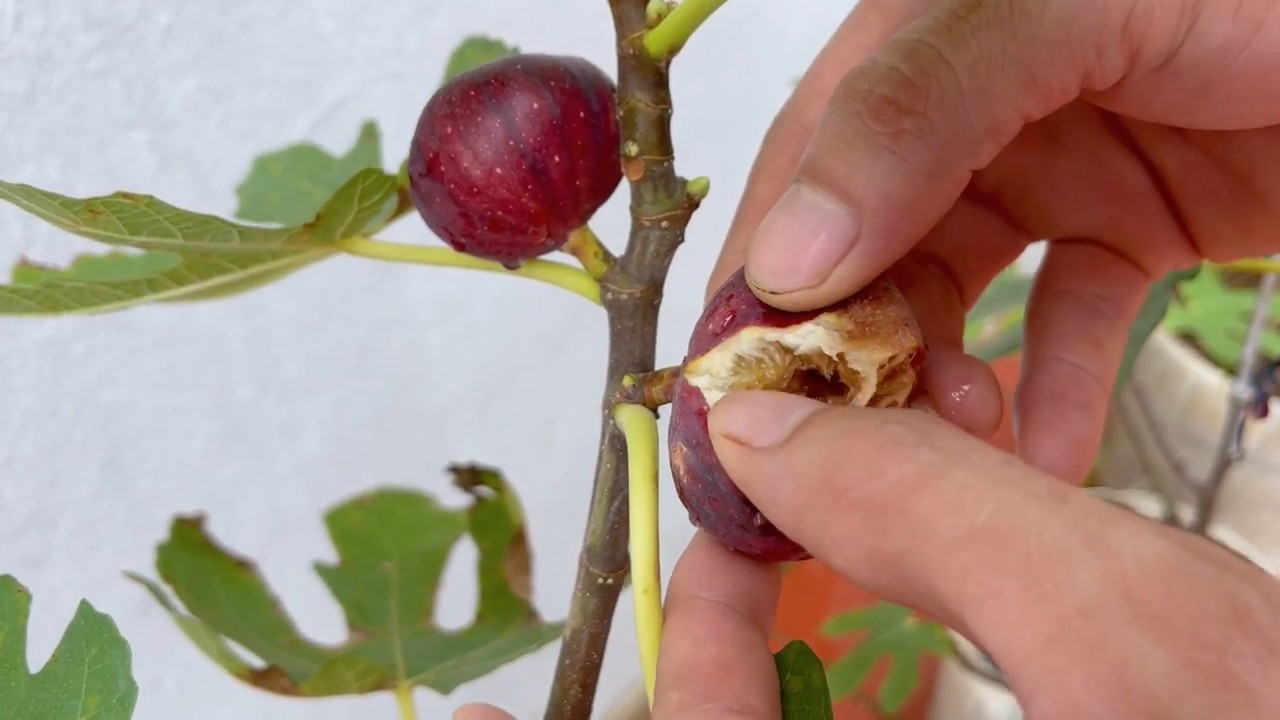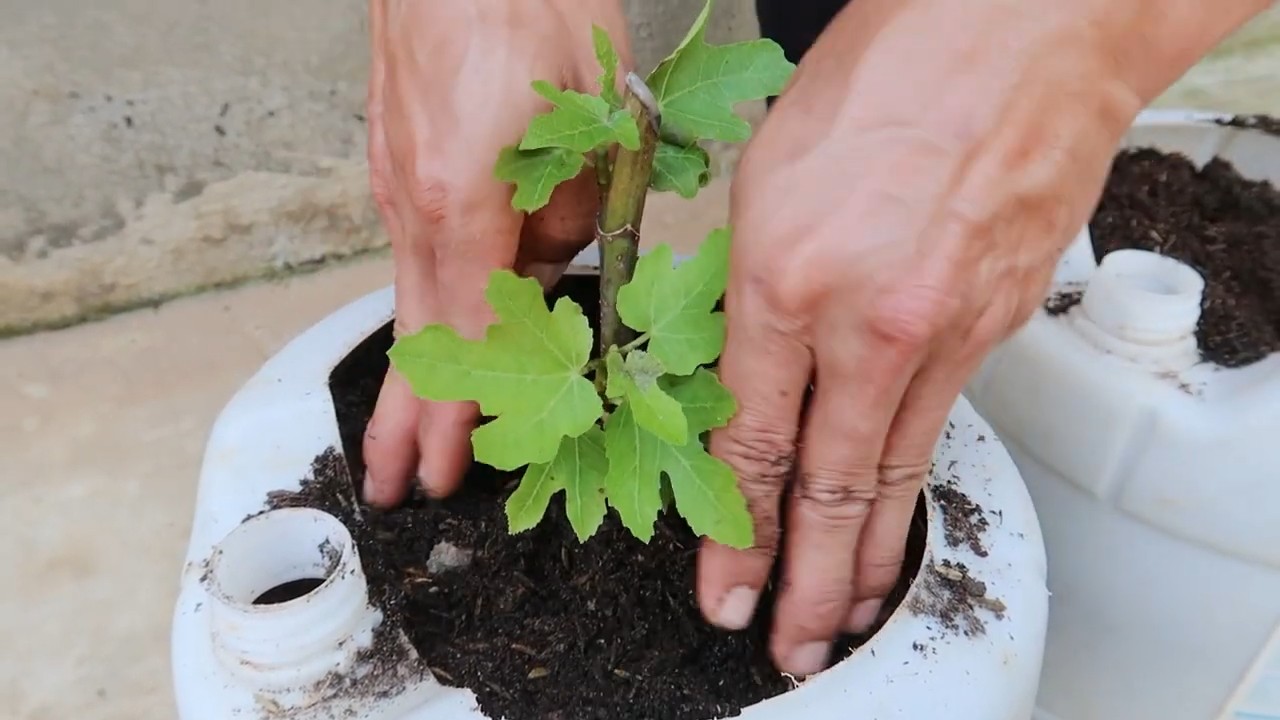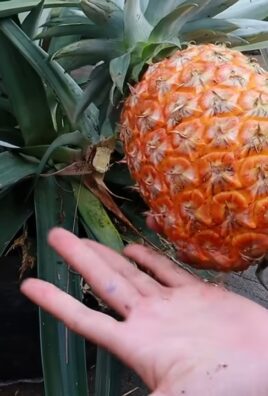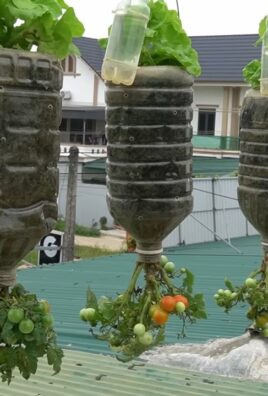Growing Figs in Containers might seem like a challenge, but trust me, it’s totally achievable, even if you don’t have a sprawling backyard! Have you ever dreamt of plucking a sun-ripened fig straight from your own tree, its sweet, jammy flavor bursting in your mouth? Well, that dream can become a reality, and I’m here to show you how.
Figs have a rich history, dating back to ancient civilizations. They were prized by the Romans and Egyptians, and even mentioned in the Bible! For centuries, they’ve symbolized prosperity and abundance. While traditionally grown in orchards, the beauty of container gardening is that it brings the orchard to you, no matter where you live.
So, why should you consider growing figs in containers? Well, for starters, it’s incredibly convenient. You can move your fig tree around to chase the sun, protect it from harsh weather, and even bring it indoors during the winter in colder climates. Plus, it’s a fantastic way to enjoy fresh, delicious figs without the commitment of a full-sized tree in the ground. This DIY guide will walk you through every step, from choosing the right container and soil to pruning and harvesting. Get ready to enjoy the sweet taste of success – and homegrown figs!

Feigen im Topf ziehen: Dein Leitfaden für eine reiche Ernte
Hey Gartenfreunde! Ich liebe Feigen. Diese süßen, saftigen Früchte sind einfach unwiderstehlich. Aber was, wenn du keinen Garten hast oder in einer Gegend mit kalten Wintern lebst? Keine Sorge! Du kannst Feigen problemlos in Töpfen ziehen und trotzdem eine reiche Ernte genießen. Ich zeige dir, wie es geht!
Warum Feigen im Topf ziehen?
* Flexibilität: Du kannst die Feige leicht an einen sonnigen Standort bringen oder sie im Winter vor Frost schützen.
* Kontrolle: Du hast die volle Kontrolle über die Bodenqualität und die Bewässerung.
* Platzsparend: Ideal für Balkone, Terrassen oder kleine Gärten.
* Frühere Ernte: Feigen im Topf fruchten oft früher als im Freiland.
Was du brauchst: Die Materialliste
* Feigenbaum-Setzling: Wähle eine Sorte, die für den Anbau im Topf geeignet ist. Beliebte Sorten sind ‘Brown Turkey’, ‘Celeste’, ‘Chicago Hardy’ oder ‘Little Miss Figgy’.
* Großer Topf: Mindestens 45 cm Durchmesser und Tiefe. Je größer, desto besser!
* Hochwertige Blumenerde: Eine gut durchlässige Mischung ist entscheidend. Ich empfehle eine Mischung aus Blumenerde, Kompost und Perlit.
* Drainagematerial: Blähton, Kies oder Tonscherben für den Topfboden.
* Gartenschere: Für den Rückschnitt.
* Gießkanne oder Schlauch: Zum Bewässern.
* Dünger: Ein ausgewogener Dünger für Obstbäume.
* Mulch: Rindenmulch oder Stroh, um die Feuchtigkeit im Boden zu halten.
* Handschuhe: Zum Schutz deiner Hände.
Schritt-für-Schritt-Anleitung: So pflanzt du deine Feige richtig
1. Den richtigen Topf auswählen: Wie gesagt, die Größe ist wichtig! Ein Topf mit mindestens 45 cm Durchmesser und Tiefe ist ein guter Anfang. Achte darauf, dass der Topf Drainagelöcher hat, damit überschüssiges Wasser ablaufen kann. Ich bevorzuge Terrakotta-Töpfe, weil sie atmungsaktiv sind und die Wurzeln gut belüften.
2. Drainage schaffen: Fülle den Boden des Topfes mit einer Schicht Drainagematerial (Blähton, Kies oder Tonscherben). Das verhindert Staunässe, die Feigen gar nicht mögen. Eine Schicht von etwa 5-7 cm ist ideal.
3. Die richtige Erde mischen: Feigen brauchen eine gut durchlässige, aber dennoch nährstoffreiche Erde. Ich mische dafür Blumenerde mit Kompost (für die Nährstoffe) und Perlit (für die Drainage). Ein Verhältnis von 2:1:1 (Blumenerde:Kompost:Perlit) hat sich bei mir bewährt. Du kannst auch spezielle Kübelpflanzenerde verwenden.
4. Den Feigenbaum einpflanzen: Nimm den Feigenbaum vorsichtig aus seinem ursprünglichen Topf. Lockere die Wurzeln etwas auf, falls sie stark verwurzelt sind. Setze den Baum mittig in den neuen Topf und fülle ihn mit der Erdmischung auf. Achte darauf, dass der Wurzelballen etwa 2-3 cm unter dem Topfrand liegt. Drücke die Erde leicht an.
5. Angießen: Gieße den Feigenbaum nach dem Einpflanzen gründlich an. Das hilft, die Erde zu setzen und die Wurzeln zu befeuchten.
Die richtige Pflege: So bleibt deine Feige glücklich
Standort
Feigen lieben die Sonne! Stelle deinen Topf an einen sonnigen Standort, der mindestens 6-8 Stunden direkte Sonneneinstrahlung pro Tag erhält. Ein Südbalkon oder eine Terrasse ist ideal.
Bewässerung
Feigen brauchen regelmäßige Bewässerung, besonders während der Wachstumsperiode und wenn sie Früchte tragen. Gieße, wenn sich die oberste Erdschicht trocken anfühlt. Vermeide Staunässe! Im Winter, wenn der Baum in Ruhe ist, reduziere die Bewässerung.
Düngung
Dünge deinen Feigenbaum während der Wachstumsperiode (Frühling und Sommer) alle 2-4 Wochen mit einem ausgewogenen Dünger für Obstbäume. Ich verwende gerne einen organischen Flüssigdünger. Im Herbst und Winter ist keine Düngung erforderlich.
Rückschnitt
Der Rückschnitt ist wichtig, um die Form des Baumes zu erhalten und die Fruchtbildung zu fördern. Schneide im späten Winter oder frühen Frühling abgestorbene, kranke oder sich kreuzende Äste ab. Du kannst auch die Triebspitzen einkürzen, um die Verzweigung anzuregen.
Überwinterung
Feigen sind nicht winterhart und müssen vor Frost geschützt werden. In kälteren Regionen solltest du den Topf im Herbst in einen kühlen, hellen Raum (z.B. Garage oder Keller) bringen. Die Temperatur sollte idealerweise zwischen 0 und 10 Grad Celsius liegen. Gieße den Baum während der Überwinterung nur sparsam. In milderen Regionen kannst du den Topf draußen lassen, aber schütze ihn mit Vlies oder Jute vor Frost.
Schädlinge und Krankheiten
Feigen sind relativ resistent gegen Schädlinge und Krankheiten. Gelegentlich können Spinnmilben oder Blattläuse auftreten. Diese kannst du mit einem Insektizid oder einer Seifenlösung bekämpfen. Achte auf Anzeichen von Pilzkrankheiten wie Rost oder Blattflecken. Entferne befallene Blätter und sorge für eine gute Belüftung.
Die Ernte: Der Lohn deiner Mühe
Die Erntezeit für Feigen ist je nach Sorte und Klima unterschiedlich. In der Regel reifen die Früchte im Spätsommer oder Herbst. Die Feigen sind reif, wenn sie weich sind und leicht vom Baum abfallen. Sie sollten auch eine intensive Farbe haben. Pflücke die reifen Feigen vorsichtig ab, um sie nicht zu beschädigen.
Häufige Probleme und Lösungen
* Keine Früchte: Möglicherweise bekommt der Baum nicht genug Sonne oder Nährstoffe. Überprüfe den Standort und dünge regelmäßig.
* Früchte fallen ab, bevor sie reif sind: Das kann an Wassermangel, Hitzestress oder einem Nährstoffmangel liegen. Sorge für ausreichend Bewässerung und Düngung.
* Gelbe Blätter: Das kann ein Zeichen für Überwässerung oder einen Nährstoffmangel sein. Überprüfe die Bewässerung und dünge gegebenenfalls.
* Schädlinge: Bekämpfe Schädlinge frühzeitig mit geeigneten Mitteln.
Zusätzliche Tipps für eine erfolgreiche Feigenernte
* Mulchen: Eine Schicht Mulch (Rindenmulch oder Stroh) um den Baum herum hilft, die Feuchtigkeit im Boden zu halten und Unkraut zu unterdrücken.
* Beschneiden der Wurzeln: Alle paar Jahre solltest du die Wurzeln des Baumes beschneiden, um zu verhindern, dass er zu stark verwurzelt. Nimm den Baum aus dem Topf und schneide etwa ein Drittel der Wurzeln ab. Pflanze ihn dann in frische Erde zurück.
* Drehen des Topfes: Drehe den Topf regelmäßig, damit alle Seiten des Baumes gleichmäßig Sonnenlicht bekommen.
* Bestäubung: Einige Feigensorten benötigen Bestäubung, um Früchte zu tragen. Wenn du eine Sorte hast, die Bestäubung benötigt, kannst du sie entweder von Hand bestäuben oder einen Feigenwespen-Lockstoff verwenden.
Ich hoffe, dieser Leitfaden hilft dir dabei, erfolgreich Feigen im Topf zu ziehen. Mit etwas Geduld und Pflege wirst du bald deine eigenen köstlichen Feigen ernten können! Viel Spaß beim Gärtnern!

Conclusion
So, there you have it! Growing figs in containers isn’t just a possibility; it’s a rewarding and accessible way to enjoy fresh, delicious figs, even if you’re short on space or live in a less-than-ideal climate. We’ve walked through the essential steps, from selecting the right container and variety to providing the necessary care and attention. The beauty of this method lies in its flexibility and control. You can move your fig tree to chase the sun, protect it from harsh winters, and curate the perfect growing environment.
But why is this DIY trick a must-try? Simply put, it democratizes fig cultivation. No longer is the joy of harvesting your own figs limited to those with sprawling orchards or Mediterranean climates. Container gardening brings this experience to balconies, patios, and even sunny indoor spaces. Imagine stepping outside your door and plucking a perfectly ripe fig, still warm from the sun. The taste is unparalleled, the satisfaction immense.
Beyond the basic guidelines, there’s ample room for experimentation and personalization. Consider these variations to tailor the experience to your specific needs and preferences:
* **Espalier Training:** Train your fig tree against a wall or trellis for a beautiful and space-saving display. This not only adds visual appeal but also maximizes sunlight exposure.
* **Different Varieties:** Explore the vast world of fig varieties! ‘Brown Turkey’ is a reliable choice for beginners, but don’t be afraid to branch out and try ‘Black Mission,’ ‘Kadota,’ or even more exotic cultivars. Each variety offers a unique flavor profile and texture.
* **Companion Planting:** Enhance your container garden by planting herbs or flowers around the base of your fig tree. Marigolds can deter pests, while basil can improve the overall health of the plant.
* **Hydroponic Fig Growing:** For the adventurous gardener, consider exploring hydroponic fig growing. This method allows for precise control over nutrient delivery and can result in faster growth and higher yields.
Ultimately, the success of growing figs in containers hinges on your willingness to learn, adapt, and provide consistent care. Pay attention to your tree’s needs, observe its growth patterns, and don’t be afraid to adjust your approach as needed. Remember, gardening is a journey, not a destination.
We wholeheartedly encourage you to embark on this fig-growing adventure. The rewards are well worth the effort. And once you’ve tasted your first homegrown fig, you’ll be hooked!
Now, we want to hear from you! Have you tried growing figs in containers? What challenges did you face? What successes did you celebrate? Share your experiences, tips, and photos in the comments below. Let’s create a community of fig enthusiasts and learn from each other. Your insights could inspire others to take the plunge and discover the joy of growing their own figs. Let’s unlock the secrets of **growing figs in containers** together!
Frequently Asked Questions (FAQ)
1. What is the best container size for growing figs?
The ideal container size for growing figs depends on the variety and the desired size of the mature tree. Generally, start with a container that is at least 15-20 gallons. As the tree grows, you may need to repot it into a larger container, eventually reaching 25-30 gallons or more for mature trees. The key is to provide ample space for the roots to develop without becoming root-bound. A root-bound tree will struggle to absorb nutrients and water, leading to stunted growth and reduced fruit production. Consider using a fabric pot, as it allows for air pruning of the roots, which promotes a healthier root system.
2. What type of soil is best for container-grown figs?
Figs thrive in well-draining soil that is rich in organic matter. A good potting mix for container-grown figs should consist of a blend of:
* **Potting Soil:** Provides a base for the mix.
* **Compost:** Adds essential nutrients and improves drainage.
* **Perlite or Vermiculite:** Enhances drainage and aeration.
Avoid using garden soil in containers, as it tends to compact and doesn’t drain well. A slightly acidic to neutral pH (around 6.0-7.0) is ideal. You can amend the soil with lime if it is too acidic.
3. How often should I water my container fig tree?
Watering frequency depends on several factors, including the size of the container, the weather, and the stage of growth. During the growing season (spring and summer), water deeply whenever the top inch of soil feels dry to the touch. Avoid overwatering, as this can lead to root rot. In the fall and winter, reduce watering frequency as the tree enters dormancy. Ensure the container has adequate drainage holes to prevent waterlogging. A moisture meter can be a helpful tool for determining when to water.
4. How much sunlight do fig trees need?
Fig trees require at least 6-8 hours of direct sunlight per day to produce abundant fruit. Choose a location that receives full sun for most of the day. If you live in a hot climate, provide some afternoon shade to prevent the leaves from scorching. Container-grown figs can be easily moved to optimize sunlight exposure throughout the year.
5. What type of fertilizer should I use for my fig tree?
Fertilize your fig tree regularly during the growing season (spring and summer) with a balanced fertilizer, such as a 10-10-10 or 20-20-20. Follow the instructions on the fertilizer package for application rates. You can also use organic fertilizers, such as compost tea or fish emulsion. Avoid fertilizing during the dormant season (fall and winter).
6. How do I protect my container fig tree from frost?
Fig trees are sensitive to frost and can be damaged by freezing temperatures. If you live in a cold climate, you will need to protect your container fig tree during the winter. Here are a few options:
* **Move the container indoors:** If possible, move the container to a garage, basement, or other sheltered location that stays above freezing.
* **Wrap the container:** Wrap the container with burlap or blankets to insulate the roots.
* **Mulch around the base of the tree:** Add a thick layer of mulch around the base of the tree to protect the roots.
* **Build a temporary shelter:** Construct a temporary shelter around the tree using plastic sheeting or other materials.
7. How do I prune my container fig tree?
Pruning is essential for maintaining the shape and productivity of your fig tree. Prune in late winter or early spring, before new growth begins. Remove any dead, damaged, or crossing branches. Thin out the canopy to improve air circulation and sunlight penetration. You can also prune to control the size and shape of the tree.
8. What are common pests and diseases that affect fig trees?
Common pests that affect fig trees include aphids, spider mites, and scale. These pests can be controlled with insecticidal soap or horticultural oil. Common diseases include fig rust and leaf spot. These diseases can be prevented by providing good air circulation and avoiding overwatering. If your tree develops a disease, treat it with a fungicide.
9. How long does it take for a container fig tree to produce fruit?
The time it takes for a container fig tree to produce fruit depends on the variety, the age of the tree, and the growing conditions. Some varieties, such as ‘Brown Turkey,’ can produce fruit in their first year. Others may take 2-3 years to begin fruiting. Providing optimal growing conditions, including adequate sunlight, water, and fertilizer, will help your tree produce fruit sooner.
10. Can I grow figs indoors year-round?
While it’s possible to grow figs indoors, it can be challenging to provide the necessary conditions for optimal growth and fruit production. Fig trees need a period of dormancy in the winter, which can be difficult to replicate indoors. If you choose to grow figs indoors, provide them with plenty of sunlight, well-draining soil, and regular fertilization. You may also need to hand-pollinate the flowers to ensure fruit set. Consider using grow lights to supplement natural sunlight.




Leave a Comment